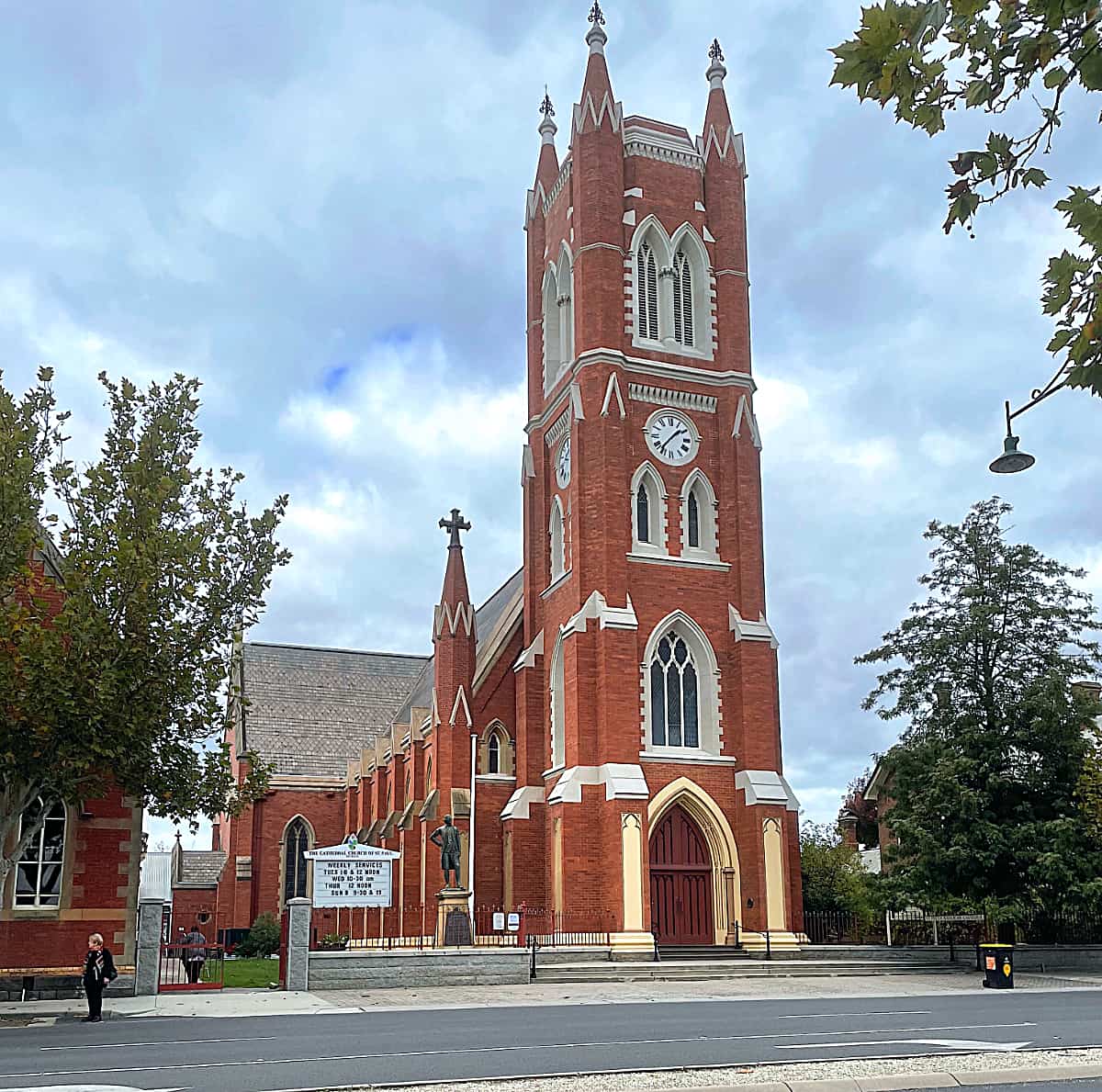
St Paul’s Anglican Cathedral, Bendigo: exterior
[photograph by John Maidment (5 May 2023)]

St Paul’s Anglican Cathedral, Bendigo: exterior
[photograph by John Maidment (5 May 2023)]
Historical and Technical Documentation by John Maidment
© OHTA, 2013 (last updated April 2013)
Building of St Paul's Church, as it was then called, began in 1868 with the construction of the nave and tower to the design of Irish-born American architect Robert Alexander Love (1814-1876) who was later a resident of Sandhurst (later Bendigo). While the foundations of the whole cruciform church were laid out, the transepts and sanctuary were not completed until 1926, based upon the original design. The nave is lofty and the tall tower, which incorporates a ring of bells, was intended to have been surmounted by a spire.1
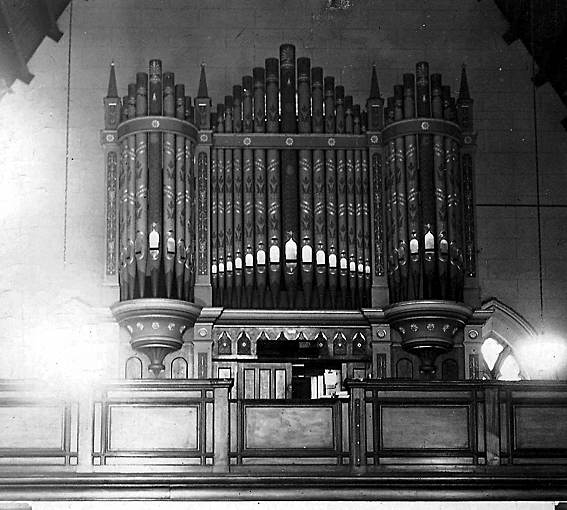
St Paul's Anglican Cathedral, Bendigo: case of the Fuller organ
(photograph by R.A. Anderson [before 1956]
The organ, built by Alfred Fuller, was first used on Sunday 29 April 1883 and was centrally placed on a rear gallery.2
ST. PAUL'S CHURCH ORGAN
The general improvement throughout the Sandhurst district in musical circles, brought about by good choral gatherings, rendering important and lasting educational effect on audiences that have listened to good performances of some of our great oratorios in this city, and also by the continual efforts being made in our midst to acquire a knowledge of music, has led to the committee of St. Paul's to consider what steps should be taken to be up with the times for the promotion of good choral as well as good congregational music. The committee unanimously agreed that the first step to be taken was the acquisition of an effective instrument, which in the hands of a skilled organist would accomplish the desired object. The contract was entrusted to the well-known organ builder, Mr. Alfred Fuller of Kew, Melbourne, who has for the past eight months been engaged upon the work, and has succeeded in producing the finest instrument, without exception, in the colony outside Melbourne and suburbs. This organ possesses several acquisitions distinct in themselves. The swell organ will be noticed to produce a most marked crescendo, and by special arrangement a crescendo can be obtained from a part of the great organ. This has been accomplished only by considerable thought and experience in these matters, and thereby a beautiful balance secured. An accessory stop to the swell organ "tremulant" has been inserted, which will produce an effect upon the "orchestral oboe" stop to resemble the human voice, or upon other stops in the swell organ. This instrument has also a double action pedal of great value. It is the first over made in the colony, and no other instrument in the colony possesses it, as it is a new invention of the builder's. On depressing the pedal it will draw out the stop "great to pedals," the next instant the same pedal depressed will take the same stop in. To an organist the value of this improvement will be obvious. The following is a description of the organ: -
Great organ contains 10 stops; Open diapason, 8 feet; horn diapason, 8 feet; claribel, 8feet; dulciana, 8 feet; principal, 4 feet; wald flote, 4 feet; twelfth, 3 feet; fifteenth, 2 feet; mixture, various; clarionet and bassoon (reed), 8 feet.
The swell organ contains 10 stops: — Double diapason, 16 feet; open diapason, 8 feet; lieblich gedact, 8 feet; viol d'Gamba, 8 feet; keraulophon, 8 feet; gemshorn, 4 feet; swabe flute, 4 feet; harmonic piccolo, 2 feet; cornopean (reed), 8 feet; oboe (reed), 8 feet. Pedal organ CCC to F.—Grand open diapason, 16 feet; Bourd[o]n diapason, 16 feet; four accessory stops—swell to great, swell to pedals, great to pedals, tremulant to swell; total number of stops, 26 ; three composition pedals to great organ; two composition pedals to swell organ ; each have a separate combination; two crescendo pedals placed and controlled by the right foot. The design for the case was approved of by the committee and is in accordance with the architecture of the church. On each side of the front it shows a bold and handsome bay or tower, the pipes of which are beautifully decorated in colors and gold. The posts that these towers spring from are pannelled and carved, the carving being relieved by etching with gold also, the whole forming a bold and handsome design, which is also from the pencil of the builder.3
| GREAT Open Diapason Horn Diapason Claribel Dulciana Principal Wald Flote Twelfth Fifteenth Mixture Clarionet and Bassoon Swell to Great SWELL Double Diapason Open Diapason Lieblich Gedact Viol di Gamba Keraulophon Gemshorn Swabe Flute Harmonic Piccolo Cornopean Oboe Tremulant PEDAL Grand Open Diapason Bourdon Great to Pedal Swell to Pedal |
8 8 8 8 4 4 3 2 [III?] 8 16 8 8 8 8 4 4 2 8 8 16 16 |
enclosed in separate box enclosed in separate box |
Compass: 56/30
Attached drawstop console (couplers and tremulant with coloured faces)
3 composition pedals to Great
2 composition pedals to Swell
Lever pedal to Swell
Lever pedal to Great enclosed stops
Fuller's instrument was of sumptuous quality, with a console fitted out in mahogany and casework and façade pipes elaborately decorated. From the rear gallery, it was moved in 1927 to a new gallery in the south transept.
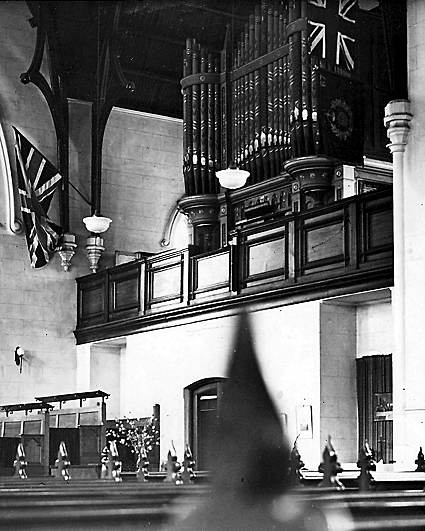
St Paul's Anglican Cathedral, Bendigo: case of the Fuller organ : view from nave
(photograph by R.A. Anderson [before 1956]
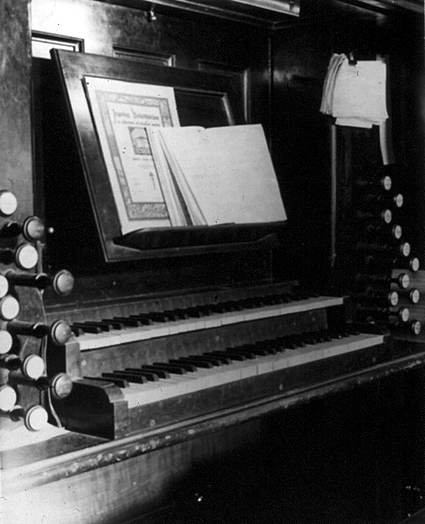
St Paul's Anglican Cathedral, Bendigo: console of the Fuller organ
(photograph by R.A. Anderson [before 1956]
This instrument was extensively rebuilt and enlarged to three manuals in 1957 by Hill, Norman & Beard (Australia) Pty Ltd. Fuller's mechanical action was discarded and a new electro-pneumatic action installed. The console, built by the English organbuilder J.W. Whiteley, came from St Andrew's Cathedral, Sydney as did the 1868 zinc Violon made by Hill & Son for another organ in the same place. A number of tonal additions were made and a Choir Organ added using a slider windchest from the 1883 organ built by George Fincham for the Presbyterian Church, West Melbourne. In 1995, the Whiteley console was replaced by a console from the 1958-59 J.W. Walker & Sons Ltd rebuild of the organ at St George's Cathedral, Perth. Elaborate new casework was supplied, designed by W.A.F. Brodie, the managing-director of Hill, Norman & Beard, and made by Hadwen & Houghton. This incorporated in the central flat the Hill pipes from Sydney, the remainder from the Fuller organ. The colourful decoration was retained. The central pipe of the Fuller case, in crimson and gold, sat for many years in a storage area at Hill, Norman & Beard's factory. The instrument was dedicated on 16 June 1957.4 The Trombone and Trumpet unit was added in 1969 (order number V758).
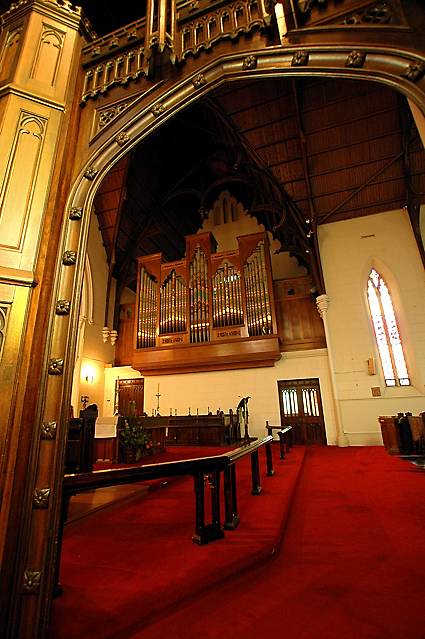
St Paul's Anglican Cathedral, Bendigo: casework of the organ as rebuilt in 1957
(photograph from the Cathedral website)
| GREAT Contrabass Open Diapason I Open Diapason II Claribel Flute Principal Flute Twelfth Fifteenth Mixture 19.22.26.29 Trumpet Swell Sub to Great Swell to Great Swell Octave to Great Choir Sub to Great Choir to Great Choir Octave to Great |
16 8 8 8 4 4 2-2/3 2 IV 8 |
A B |
Hill & Son 1-30 ex Swell ex Swell new; added after 1957 HN&B 1969 |
| SWELL Lieblich Gedeckt Open Diapason Gedeckt Salicional Vox Angelica Gemshorn Sesquialtera 17.19.22 Contra Oboe Posaune Oboe Octave Oboe Tremulant Swell Sub Swell Unison Off Swell Octave |
16 8 8 8 8 4 III 16 8 8 4 |
C D D D |
ex Great Horn Diapason new TC new |
| CHOIR Rohr Flote Dulciana Gemshorn Nazard Piccolo Tierce Sifflote Krummhorn Trumpet Tremulant Choir Sub Choir Octave Swell to Choir |
8 8 4 2-2/3 2 1-3/5 1 8 8 |
B |
(enclosed except Trumpet) new ex Great new? new ex Swell new new ex Great |
| PEDAL Open Wood Contrabass Bourdon Lieblich Gedeckt Quint Octave Flute Octave Flute Trombone Great to Pedal Swell to Pedal Choir to Pedal |
16 16 16 16 10-2/3 8 8 4 16 |
E A F C F E F F B |
HN&B 1969 |
Compass: 56/30
Electro-pneumatic action
Detached drawstop console5
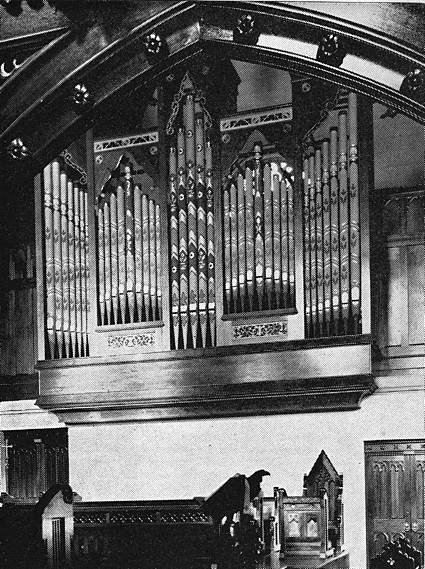
St Paul's Anglican Cathedral, Bendigo: close up view of the casework
(dedication brochure 1957)
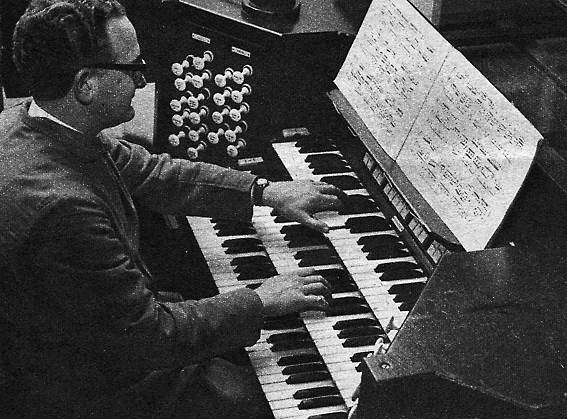
St Paul's Anglican Cathedral, Bendigo: Hedley Jones at the Whiteley console
(Bendigo Advertiser 17 September 1969)
1 Mike Butcher & Gill Flanders, Bendigo Historic Buildings (Bendigo: National Trust of Australia (Victoria) Central Victorian Branch, 1987) p.57; Mike Butcher, Robert Alexander Love Goldfields Architect (1814-1876) (Strathdale, Vic.: Holland House Publishing, 2000), pp. 74-76
2 Bendigo Advertiser 30 April 1883, p.3
3 Ibid., 23 April 1883, p.2
4 St Paul's Church, Bendigo; Dedication of the Rebuilt Organ Trinity Sunday, June 16th, 1957
5 Specification noted 1966 John Maidment and from organ dedication brochure (some minor differences in nomenclature now exist with the replacement console, such as the Contrabass now more correctly called Violone)